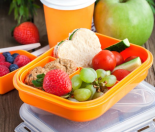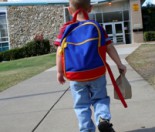It can be tough buying school clothes that are practical but cool for the playground. We’ve got some top tips for buying school clothes to help make your job a little easier.
Last year my children’s primary school introduced a uniform, and all I can say is, ‘thank goodness for small mercies!’
We no longer have debates about what can and can’t be worn to school, and our morning ritual has become somewhat shorter minus the fashion parades.
For all the negative arguments about uniforms, they have definitely made life easier for us, and I wonder why I didn’t adopt a uniform, mentally, years ago.
Uniforms take away all the arguments and questioning, and give you clear guidelines about which clothes are practical in the playground. Without a uniform, you need to negotiate all of those issues with your child, and if they’re a diva like mine, there will be plenty of issues to sort out…every morning!
What is (and isn’t!) appropriate clothing for school? “Why can’t I wear my best jeans to Messy Play Monday?” “Why can’t we buy that $100 t-shirt with Brand X emblazoned across the front?…everyone else has one!!”
If you’re in the no-uniform zone, this article will give you some useful tips for negotiating, and help you decipher just which clothes are necessary and practical in the playground.
What do they need?
Even if your child’s school does not have a uniform, they will usually have some guidelines as to what clothing is required or appropriate. The guidelines may differ slightly from school to school, but generally your child will need the following:
Sun Hat
Most schools have a strict Sunsmart policy which requires children to wear a sun hat outside during terms 1 and 4.
There are obviously many different styles available, but the 3 which provide the most protection are:
- The wide brimmed swagman hat (think Australian outback)
- The bucket or surfie hat (with a brim at least 6cm wide around the entire circumference)
- The legionnaire hat (which is like a cap with flaps covering the neck and ears).
These styled hats are available from most children’s clothing stores and and from school uniform stockists like Postie Plus.
When choosing a hat for school, you should also consider the fabric colour and weave. Dark fabrics with a close weave provide more protection from the sun than light, loosely woven fabric. For more information on hats that are sun-smart, see our article on Sun Safety.
To avoid the ‘that doesn’t match my outfit’ debate, buy a sunhat which is specifically for school – regardless of what they might be wearing. Stitch a tag or loop to the hat so it can be hung off your child’s school bag, and insist that it lives either there or on their head. That way they always know where their school hat is, and there’s no morning madhouse routine.
T-Shirts
In the height of summer heat, sleeveless tops seem like a cooler option for children in hot classrooms, but they provide no sun protection for their shoulders in the playground. Make sure that all T-shirts have sleeves that cover your child’s shoulders, and that necklines do not scoop too low at the back or front of the neck. Collared shirts offer the most sun protection.
Look for shirts in darker colours, as these offer more protection from the sun (and don’t show up so many paint splatters from art day!). Tightly woven fabrics also provide more protection, but this doesn’t mean the fabric has to be heavy and hot. Loose fitting shirts will give your child room to breathe and keep them cool.
Sweatshirts
Unless you’re in the deep south and surrounded by snow, your child won’t need a sweatshirt designed for Antarctica. Polar fleece sweatshirts seem to be the most practical, hard-wearing option, and you can buy micro-fleece versions that are not big and bulky to put in your child’s bag. To ensure the sweatshirt remains presentable wash after wash, look for fleece that is anti-pill.
Pants / Skirts
Whatever your child wears on the bottom half needs to be practical. Tight jeans, short skirts and baggy pants that hang off their waists are a nightmare for teachers trying to facilitate outdoor games and activities. Of course, your child won’t like PE if they can’t bend, run or stretch without falling over.
Primary schools don’t necessarily have a specific day for sports, but instead teachers often take the class outside for activities to break up the day. You don’t usually need to purchase specialised sports gear for this, but make sure your child can move about easily and comfortably in their everyday school clothes. Track pants, loose fitting or stretch fabric shorts, and drawstring capri pants are all good options.
Shoes
Like your child’s other clothes, school shoes need to be practical. Even if there is no organised sports activity, your child will still need to get around the playground safely. Heels are definitely out (no matter how small), and fashion slip-ons or jandals can also cause some problems. The most suitable shoes for school are sneakers or sports sandals. For more detailed information check out our article on School Shoes.
Raincoat / Jacket
There will be times during the day when your child needs to move about the school for various reasons, so during the winter months your child will need a raincoat or jacket, even if they are driven to school by car or bus. Look for bright coloured coats with reflectors, which will help your child be seen as they cross roads or bike to school, and make sure the hood has a drawstring so it can be pulled tightly around the face. Not only does this provide better protection from the rain, it is safer for your child as it allows a clear ‘side view’ rather than them looking into the hood.
If your child walks or bikes to school they will need a coat that comes to the centre of their thighs at least. Shorter jackets are okay for children who are dropped off and picked up at the gate. Remember, your child’s coat is mostly for the rain, not a snow storm. Big padded jackets just clog up their already overflowing school bags.
The Fashion Debate
Somewhere between 7 and 9 years old, your child is likely to discover they have a distinct taste in fashion, and it won’t always be practical or within your budget to meet their demands. Here are some ways you might come to a compromise if your child is determined to be a ‘label’ queen (or king!).
Tops and bottoms
Agree to buy a selection of ‘school suitable’ tops with a trendy brand. Your child can mix and match the tops with less expensive bottoms and still look the part.
Topping up
Explain the difference in cost between generic and designer brands, and suggest if your child wants to ‘upgrade’ that they can pay the difference. (Of course this only works if your child has pocket money or birthday money to spend, or if they are older, a part time job).
Give them a budget
Make a list of how many tops and bottoms they need for school, and (after doing your homework) give them an appropriate budget to work to. They may choose to buy some items more cheaply than you allowed for, so that they can have a bit extra to buy one or two items with specific brands.
Second hand
Look around second hand shops for quality ‘labelled’ clothes, or search on TradeMe for your child’s favourite brand. Often the clothes are last season, but at this age it’s still more about the name than the date (thankfully!).
Presents
Use birthdays and Christmas as an opportunity to buy clothes that your child actually needs, but with the super flash brand they have been pining for. Ask grandparents and other family members if they can do the same.
Half and half
Encourage your child to save up for their own designer clothes, and as an incentive offer to meet them half way. You’ll end up only spending what you would have otherwise spent, and they are learning good saving habits at the same time.
Top Tips for Saving Money on School Clothes
- Make it known to friends and family that you would welcome good quality hand-me-downs.
- Try to avoid buying expensive, branded clothes if you can.
- Buy good quality, durable clothes for your children that will last a whole season and can then be passed onto younger children or sold second hand.
- Always buy clothes at least 1 size bigger for your child, to ensure that they last through this season’s inevitable growth spurt!
- Look for good quality second hand clothes in second hand clothing shops or on TradeMe. TradeMe is particularly good for finding bundles of good quality clothes for a particular age, gender and season.
- If you have to buy a school uniform then look around for second hand options – you can search in school uniform shops, school noticeboards, on TradeMe, or by chatting to other parents with children at your school.






